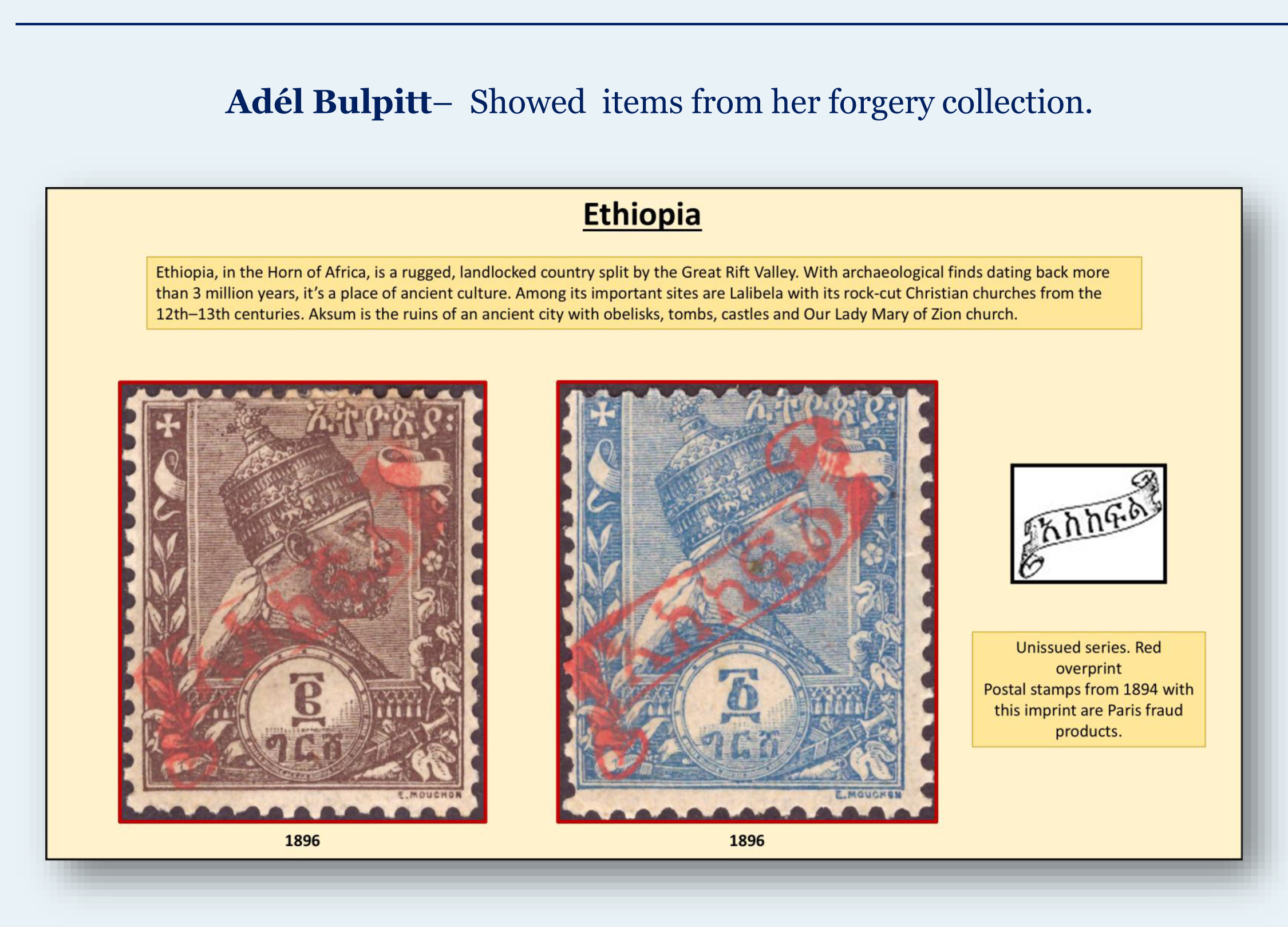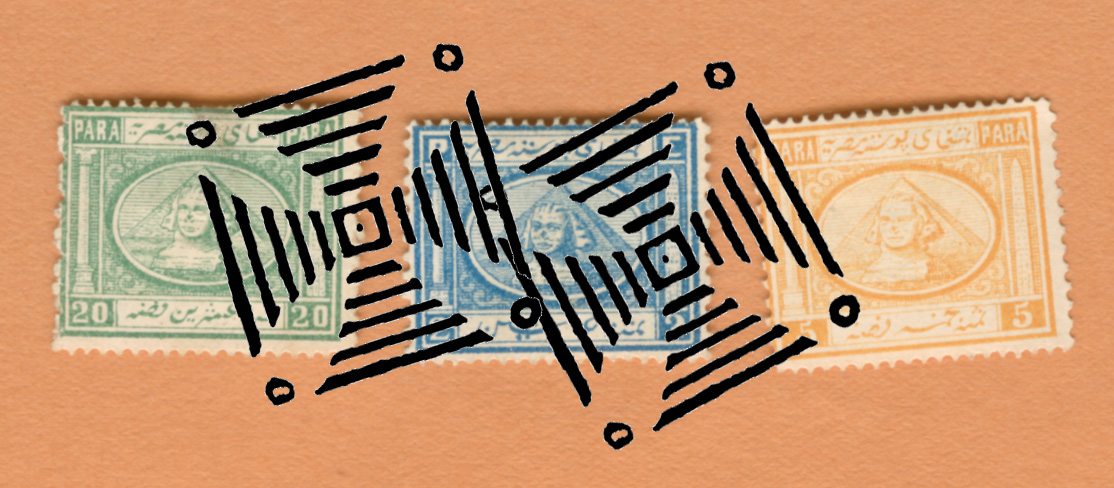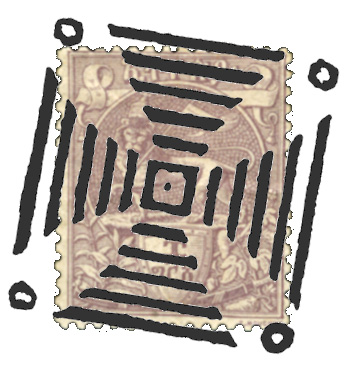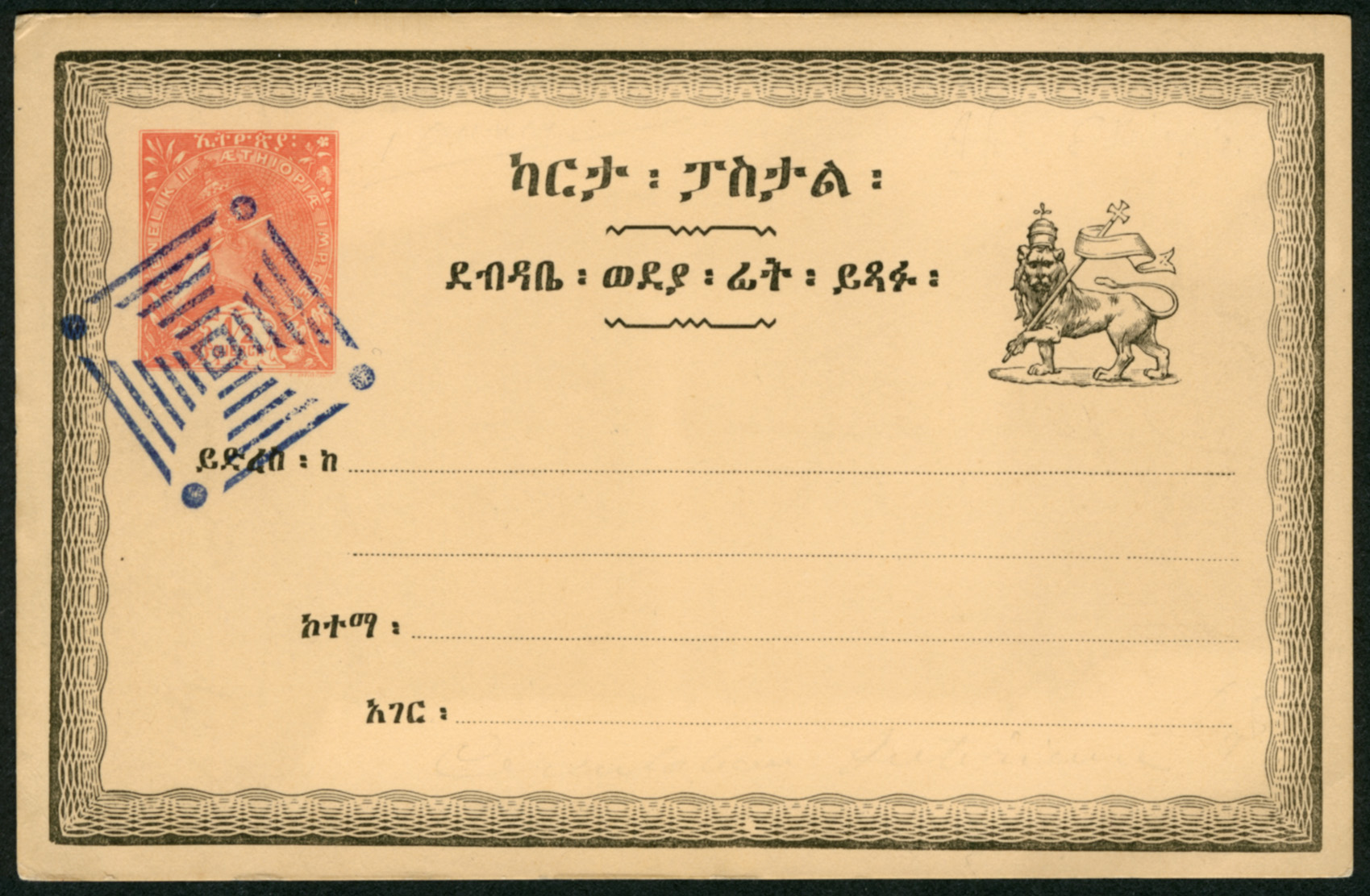ETHIOPIA - Its History, Stamps, Overprints and Postmarks
Quote from Steve on November 1, 2024, 10:11 amHi Karel,
First, welcome to the SAPC (SA Philately Club). Please continue to use this Forum to post more comments and images like the preceding on any subject that you are interested in.
Second, I am far from an authority on Ethiopian stamps and its postal history. I am an enthusiastic fan of the subject, no more. Over the years I have acquired two small stockbooks at different times with an assortment of Ethiopian stamps, some early but most from the 1920s to 1960s. It was always my intention to do something with them but I never did. I would very occassionally buy items that caught my eye at fairs and online. I am a sucker for anything pretty and enchanting and a lot of early Ethiopia is just that.
However, I never did anything with this material until after Jamie and I started the SAPC site. A year or so ago I found myself without material to post and nobody except Jamie contributing anything. As a result, I decided to 'quickly' write up my Ethiopia. There are more experienced collectors who would probably not dare to do this given its complexities. More fool me. This article is probably about one month's work starting on a subject I knew nothing about. I guess I should have known better and shown more deference to all serious Ethiopian philatelists who would see my attempt for what it was, the entry-level work of a non-academic beginner.
In writing this up I began with a British dealer's 'Collect Ethiopia' handbook from the 1930s. It was not at all useful and I have now misplaced it. It only listed the issues this dealer had for sale. It certainly did not go into any detail about 'provincial blocks'. As I was frustrated by my lack of knowledge and the unavailabity of a useful reference work, I made an online purchase of the 'Handbook of the Postage Stamps of the Empire of Ethiopia and Her Postal System’. (Part 1. Ivan Adler, Knight of the Star Order of Ethiopia, Stockholm, Sweden. 1961.) I used this extensively to write the preceding article.
My rerefences to "a wrapper containing the original 200 ‘provincial blocks’" comes from it. Given the date that Adler's book is published, 1961, he was writing up what he thought was correct at the time. I should have known better and checked his references against more recent texts. In my haste get something up I did not. I apologise. Taking a positive out of this, we are now all the wiser for your joining the SAPC and making this contribution. Without excusing myself, we are allowed to make errors provided we are willing to be corrected. I certainly am. Perhaps the terror of being tripped up in public like this is what prevents many readers from contributing here. It should not. This is simply a Forum. Thank you for using it as it was intended.
If you think it worthwhile to continue, please add more material. Ethiopia is a wonderful collecting field, one which I now wish I had studied more fully. I agree with Jamie. If I have a second life to live I will pursue Ethiopia in the next with all the passion and disciplne that it deserves.
Hi Karel,
First, welcome to the SAPC (SA Philately Club). Please continue to use this Forum to post more comments and images like the preceding on any subject that you are interested in.
Second, I am far from an authority on Ethiopian stamps and its postal history. I am an enthusiastic fan of the subject, no more. Over the years I have acquired two small stockbooks at different times with an assortment of Ethiopian stamps, some early but most from the 1920s to 1960s. It was always my intention to do something with them but I never did. I would very occassionally buy items that caught my eye at fairs and online. I am a sucker for anything pretty and enchanting and a lot of early Ethiopia is just that.
However, I never did anything with this material until after Jamie and I started the SAPC site. A year or so ago I found myself without material to post and nobody except Jamie contributing anything. As a result, I decided to 'quickly' write up my Ethiopia. There are more experienced collectors who would probably not dare to do this given its complexities. More fool me. This article is probably about one month's work starting on a subject I knew nothing about. I guess I should have known better and shown more deference to all serious Ethiopian philatelists who would see my attempt for what it was, the entry-level work of a non-academic beginner.
In writing this up I began with a British dealer's 'Collect Ethiopia' handbook from the 1930s. It was not at all useful and I have now misplaced it. It only listed the issues this dealer had for sale. It certainly did not go into any detail about 'provincial blocks'. As I was frustrated by my lack of knowledge and the unavailabity of a useful reference work, I made an online purchase of the 'Handbook of the Postage Stamps of the Empire of Ethiopia and Her Postal System’. (Part 1. Ivan Adler, Knight of the Star Order of Ethiopia, Stockholm, Sweden. 1961.) I used this extensively to write the preceding article.
My rerefences to "a wrapper containing the original 200 ‘provincial blocks’" comes from it. Given the date that Adler's book is published, 1961, he was writing up what he thought was correct at the time. I should have known better and checked his references against more recent texts. In my haste get something up I did not. I apologise. Taking a positive out of this, we are now all the wiser for your joining the SAPC and making this contribution. Without excusing myself, we are allowed to make errors provided we are willing to be corrected. I certainly am. Perhaps the terror of being tripped up in public like this is what prevents many readers from contributing here. It should not. This is simply a Forum. Thank you for using it as it was intended.
If you think it worthwhile to continue, please add more material. Ethiopia is a wonderful collecting field, one which I now wish I had studied more fully. I agree with Jamie. If I have a second life to live I will pursue Ethiopia in the next with all the passion and disciplne that it deserves.
Uploaded files:Quote from Karel on November 1, 2024, 9:26 pmHi Steve
Thank you for your quick reply, for the warm welcome to the SAPC and for sharing the background of your interest in postage stamps of Ethiopia.
I know very little about Ethiopian stamps and postal history, I am focused primarily on other territories (such as Stellaland and British Bechuanaland) but being also an ASFE (A Stamp From Everyone) collector and writing sometimes about stamps in my mother tongue (Czech) I have become a little bit interested in Ethiopia as well, have bought the book by Roberto Sciaky and have read some on-line texts such as the webpage of the Ethiopian Philatelic Society or your own text on this forum. I want to understand a bit better what is an authentic postal history or stamp item and what is a bogus or a forgery (ASFE collectors can be easily fooled as they may often lack the necessary depth of knowledge). Early Ethiopia appears to be inundated by various dubious issues (partly even produced by Mr Michel the Director of the Ethiopian Post in the early 1900s, either during or after his tenure) while at the same time it is indeed fascinating. That was why I asked you about the ‘province’ stamps / block. Your reference to Adler (1961) makes it clearer; Sciaky's more recent information (1999) which appears to be consistent with the description by Cherrystone (2017) might be closer to the current knowledge as you have suggested although we would probably need to ask the experts like Ulf Lindhal to be sure.
No need to apologise, in fact I was impressed by your presentation of early Ethiopia and the level of enthusiasm which is contagious and makes the reader search for more information!
Karel
Hi Steve
Thank you for your quick reply, for the warm welcome to the SAPC and for sharing the background of your interest in postage stamps of Ethiopia.
I know very little about Ethiopian stamps and postal history, I am focused primarily on other territories (such as Stellaland and British Bechuanaland) but being also an ASFE (A Stamp From Everyone) collector and writing sometimes about stamps in my mother tongue (Czech) I have become a little bit interested in Ethiopia as well, have bought the book by Roberto Sciaky and have read some on-line texts such as the webpage of the Ethiopian Philatelic Society or your own text on this forum. I want to understand a bit better what is an authentic postal history or stamp item and what is a bogus or a forgery (ASFE collectors can be easily fooled as they may often lack the necessary depth of knowledge). Early Ethiopia appears to be inundated by various dubious issues (partly even produced by Mr Michel the Director of the Ethiopian Post in the early 1900s, either during or after his tenure) while at the same time it is indeed fascinating. That was why I asked you about the ‘province’ stamps / block. Your reference to Adler (1961) makes it clearer; Sciaky's more recent information (1999) which appears to be consistent with the description by Cherrystone (2017) might be closer to the current knowledge as you have suggested although we would probably need to ask the experts like Ulf Lindhal to be sure.
No need to apologise, in fact I was impressed by your presentation of early Ethiopia and the level of enthusiasm which is contagious and makes the reader search for more information!
Karel
Quote from Steve on October 7, 2025, 2:54 pmAdel Bulpitt has shared these Ethiopia Overprints forged in Paris with us. They are from her October 2025 Newsletter.
Adel Bulpitt has shared these Ethiopia Overprints forged in Paris with us. They are from her October 2025 Newsletter.

Quote from Steve on December 10, 2025, 3:30 pmI began this post with "Ethiopia's First Postmarks and the Mystery of the Egyptian Harrar Canceller." I found a possible examplke of this canceller and created an image of the Maltese Cross handstamp cancelling Egyptian stamps as used in Harrar in 1875.
Subsequently I created the following as an example of what it might have looked like cancelling an Ethiopian stamp.
Recently I discoverd this item of postal stationery. It is a bit disappointing as it is not postally used. (It would have cost a small fortune if it was! This did not.) Generally I shy clear of cancelled stamps on cover or postcard that are unaddressed. What intrigued me about this postcard is the blue Maltese Crtoss postmark. Is this the Harrar canceller? I am willing to accept that both it and the card are is fake.
1896. Postal Stationery Card. 1/2g pre-cancelled with Blue Maltese Cross.
I have nothing known to be genuine to compare this to. Comparison with similar eBay items suggests that this is a genuine Ethiopian 1896 1/2 guerche postal stationery card, slight corner crease, top left, blank on reverse. (Engraved by E. Mouchon and typographed by Atelier de Fabrication des Timbres, Paris; Printed 15-17 June 1896. Cards were delivered to Chefneaux in Paris on 15 July 1896.)
The Harrar Maltese Cross canceller was used on Egyptian stamps in 1875. This card was produced in 1896. My thought is that this probaly some mischevious soul having a bit of philatelic fun. Whatever this is, it has a tale to tell. Can you add to it?
There are unused and uncancelled examples of this postcard selling on eBay for a lot of money. I like this one!
I began this post with "Ethiopia's First Postmarks and the Mystery of the Egyptian Harrar Canceller." I found a possible examplke of this canceller and created an image of the Maltese Cross handstamp cancelling Egyptian stamps as used in Harrar in 1875.

Subsequently I created the following as an example of what it might have looked like cancelling an Ethiopian stamp.

Recently I discoverd this item of postal stationery. It is a bit disappointing as it is not postally used. (It would have cost a small fortune if it was! This did not.) Generally I shy clear of cancelled stamps on cover or postcard that are unaddressed. What intrigued me about this postcard is the blue Maltese Crtoss postmark. Is this the Harrar canceller? I am willing to accept that both it and the card are is fake.
 1896. Postal Stationery Card. 1/2g pre-cancelled with Blue Maltese Cross.
1896. Postal Stationery Card. 1/2g pre-cancelled with Blue Maltese Cross.
I have nothing known to be genuine to compare this to. Comparison with similar eBay items suggests that this is a genuine Ethiopian 1896 1/2 guerche postal stationery card, slight corner crease, top left, blank on reverse. (Engraved by E. Mouchon and typographed by Atelier de Fabrication des Timbres, Paris; Printed 15-17 June 1896. Cards were delivered to Chefneaux in Paris on 15 July 1896.)
The Harrar Maltese Cross canceller was used on Egyptian stamps in 1875. This card was produced in 1896. My thought is that this probaly some mischevious soul having a bit of philatelic fun. Whatever this is, it has a tale to tell. Can you add to it?
There are unused and uncancelled examples of this postcard selling on eBay for a lot of money. I like this one!
Quote from Karel on December 12, 2025, 5:23 pmHi Steve, I am writing to follow up on your questions regarding the Maltese Cross postmark and its use in Ethiopia. You have mentioned the list of pre-UPU cover of Ethiopia compiled by Luciano Maria. The same Luciano Maria also wrote several articles which I believe shed more light on the subject and review and in some cases correct previous hypotheses made by Ivan Adler and Henri Tristant. In particular, the article "The first cancellors of Harar and Entoto" by Roberto Sciaky and Luciano Maria in Menelik's Journal Vol. XVII, No. 4 (Oct–Dec 2001), pages 5–11 (pages 10 and 11 are relevant), the article "The Maltese Cross and Its use in Addis Ababa in 1907" also by Roberto Sciaky and Luciano Maria in Menelik's Journal Vol. XVIII, No. 2 (Apr–Jun 2002), pages 12–14 and a more recent article "The Maltese Cross Postmark" by Luciano Maria in Menelik's Journal 35, No. 1 (Jan-Mar 2019), pages 22–30. For example, the first article says that "We demonstrated that the Maltese Cross was not used in Harar as previously reported but was used in Addis Abeba to face a lack of cancellers." The third article for example refers to previous findings that the Maltese Cross canceller was received in 1918 by J. A. Michel (together with other Ethiopian cancellers and postal material) as a payment for a credit he had against the Ethiopian government for his services as an advisor and then he probably created a number of faked items of "Ethiopian postal history". The same article also provides an updated list of genuine 1897 covers with the Maltese Cross canceller (7) and refers to the list of pre-UPU covers which includes 6 genuine 1907 covers with this canceller. I am not sure whether you have access to these articles or not but I wanted to mention them here just in case. I attach a picture of a small part of one of the articles.
Hi Steve, I am writing to follow up on your questions regarding the Maltese Cross postmark and its use in Ethiopia. You have mentioned the list of pre-UPU cover of Ethiopia compiled by Luciano Maria. The same Luciano Maria also wrote several articles which I believe shed more light on the subject and review and in some cases correct previous hypotheses made by Ivan Adler and Henri Tristant. In particular, the article "The first cancellors of Harar and Entoto" by Roberto Sciaky and Luciano Maria in Menelik's Journal Vol. XVII, No. 4 (Oct–Dec 2001), pages 5–11 (pages 10 and 11 are relevant), the article "The Maltese Cross and Its use in Addis Ababa in 1907" also by Roberto Sciaky and Luciano Maria in Menelik's Journal Vol. XVIII, No. 2 (Apr–Jun 2002), pages 12–14 and a more recent article "The Maltese Cross Postmark" by Luciano Maria in Menelik's Journal 35, No. 1 (Jan-Mar 2019), pages 22–30. For example, the first article says that "We demonstrated that the Maltese Cross was not used in Harar as previously reported but was used in Addis Abeba to face a lack of cancellers." The third article for example refers to previous findings that the Maltese Cross canceller was received in 1918 by J. A. Michel (together with other Ethiopian cancellers and postal material) as a payment for a credit he had against the Ethiopian government for his services as an advisor and then he probably created a number of faked items of "Ethiopian postal history". The same article also provides an updated list of genuine 1897 covers with the Maltese Cross canceller (7) and refers to the list of pre-UPU covers which includes 6 genuine 1907 covers with this canceller. I am not sure whether you have access to these articles or not but I wanted to mention them here just in case. I attach a picture of a small part of one of the articles.
Uploaded files:

